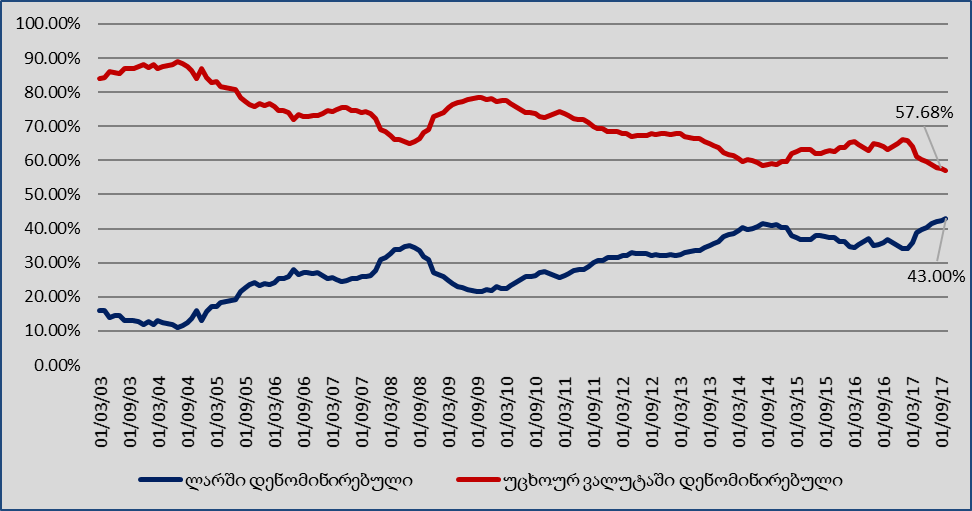On 3 November 2017, the Minister of Finance, Dimitri Kumsishvili, emphasised the situation in regard to poverty in his talk about Georgia’s economic indicators. Mr Kumsishvili stated: “In 2012, the poverty rate was nearly 29%. We have lowered it to 21%. Even though 500,000 individuals no longer live in poverty, 700,000 people are still below the poverty line. This, of course, remains our country’s biggest challenge.”
FactCheck verified the accuracy of the Minister of Finance’s statement.
According to the absolute poverty figures, 28.9% of Georgia’s population was below the poverty line in 2012. In the period of 2011-2015, the absolute poverty figures were showing an annual decline. However, the amount of people who lived below the absolute poverty line in 2016 increased by 0.5 of a percentage point (see Graph 1). Of particular note is that the poverty rate is especially high in rural areas. As of 2016, 25.5% of the rural population lives in poverty whilst this figure is 16.9% in urban areas.
The National Statistics Office of Georgia published the preliminary figures of absolute poverty in 2017. The methodology for calculating absolute poverty is based on the World Bank’s basic needs method. The poverty line is defined by considering a population’s income and expenses corresponding to the minimum subsistence level.
Graph 1: Share of Population Below the Absolute Poverty Line
 Source: National Statistics Office of Georgia
The National Statistics Office of Georgia does not publish the number of the country’s poor. Therefore, it is impossible to say precisely how many people are living in poverty today. If we compare the percentage of poverty to the total amount of the population, we will see that approximately 790,000 individuals were living in poverty as of 2016. The National Statistics Office of Georgia clarified that the results of the 2014 universal public census were used to calculate the absolute poverty figures which put the population at nearly 3.7 million. If we use the 2014 universal public census results to calculate the poverty figures for the year 2012, for example, we will see that approximately 1,070,000 individuals were living in poverty. Therefore, the number of people living in poverty has dropped by about 280,000. If we do not use the results of the universal public census, the number of the country’s poor is 500,000. This said, it would be inappropriate not to use the official statistics (universal public census).
Conclusion
In 2012, 28.9% of Georgia’s population was living in poverty whilst this figure dropped to 21.3% in 2016. The trend for a decrease in poverty started in 2011 with the poverty showing an annual drop in the period of 2011-2015. The poverty rate increased by 0.5 of a percentage point in 2016.
Even though Dimitri Kumsishvili has correctly named the poverty figures and underlined that poverty remains the most important challenge for Georgia, he has ignored the fact that the poverty rate did in fact increase in 2016. Additionally, when the Minister says that 500,000 people no longer live in poverty, he does not consider the universal public census to calculate the absolute poverty numbers. Based on the official statistics (universal public census), the number is approximately 280,000.
FactCheck concludes that Dimitri Kumsishvili’s statement is HALF TRUE.
Source: National Statistics Office of Georgia
The National Statistics Office of Georgia does not publish the number of the country’s poor. Therefore, it is impossible to say precisely how many people are living in poverty today. If we compare the percentage of poverty to the total amount of the population, we will see that approximately 790,000 individuals were living in poverty as of 2016. The National Statistics Office of Georgia clarified that the results of the 2014 universal public census were used to calculate the absolute poverty figures which put the population at nearly 3.7 million. If we use the 2014 universal public census results to calculate the poverty figures for the year 2012, for example, we will see that approximately 1,070,000 individuals were living in poverty. Therefore, the number of people living in poverty has dropped by about 280,000. If we do not use the results of the universal public census, the number of the country’s poor is 500,000. This said, it would be inappropriate not to use the official statistics (universal public census).
Conclusion
In 2012, 28.9% of Georgia’s population was living in poverty whilst this figure dropped to 21.3% in 2016. The trend for a decrease in poverty started in 2011 with the poverty showing an annual drop in the period of 2011-2015. The poverty rate increased by 0.5 of a percentage point in 2016.
Even though Dimitri Kumsishvili has correctly named the poverty figures and underlined that poverty remains the most important challenge for Georgia, he has ignored the fact that the poverty rate did in fact increase in 2016. Additionally, when the Minister says that 500,000 people no longer live in poverty, he does not consider the universal public census to calculate the absolute poverty numbers. Based on the official statistics (universal public census), the number is approximately 280,000.
FactCheck concludes that Dimitri Kumsishvili’s statement is HALF TRUE.
 Source: National Statistics Office of Georgia
The National Statistics Office of Georgia does not publish the number of the country’s poor. Therefore, it is impossible to say precisely how many people are living in poverty today. If we compare the percentage of poverty to the total amount of the population, we will see that approximately 790,000 individuals were living in poverty as of 2016. The National Statistics Office of Georgia clarified that the results of the 2014 universal public census were used to calculate the absolute poverty figures which put the population at nearly 3.7 million. If we use the 2014 universal public census results to calculate the poverty figures for the year 2012, for example, we will see that approximately 1,070,000 individuals were living in poverty. Therefore, the number of people living in poverty has dropped by about 280,000. If we do not use the results of the universal public census, the number of the country’s poor is 500,000. This said, it would be inappropriate not to use the official statistics (universal public census).
Conclusion
In 2012, 28.9% of Georgia’s population was living in poverty whilst this figure dropped to 21.3% in 2016. The trend for a decrease in poverty started in 2011 with the poverty showing an annual drop in the period of 2011-2015. The poverty rate increased by 0.5 of a percentage point in 2016.
Even though Dimitri Kumsishvili has correctly named the poverty figures and underlined that poverty remains the most important challenge for Georgia, he has ignored the fact that the poverty rate did in fact increase in 2016. Additionally, when the Minister says that 500,000 people no longer live in poverty, he does not consider the universal public census to calculate the absolute poverty numbers. Based on the official statistics (universal public census), the number is approximately 280,000.
FactCheck concludes that Dimitri Kumsishvili’s statement is HALF TRUE.
Source: National Statistics Office of Georgia
The National Statistics Office of Georgia does not publish the number of the country’s poor. Therefore, it is impossible to say precisely how many people are living in poverty today. If we compare the percentage of poverty to the total amount of the population, we will see that approximately 790,000 individuals were living in poverty as of 2016. The National Statistics Office of Georgia clarified that the results of the 2014 universal public census were used to calculate the absolute poverty figures which put the population at nearly 3.7 million. If we use the 2014 universal public census results to calculate the poverty figures for the year 2012, for example, we will see that approximately 1,070,000 individuals were living in poverty. Therefore, the number of people living in poverty has dropped by about 280,000. If we do not use the results of the universal public census, the number of the country’s poor is 500,000. This said, it would be inappropriate not to use the official statistics (universal public census).
Conclusion
In 2012, 28.9% of Georgia’s population was living in poverty whilst this figure dropped to 21.3% in 2016. The trend for a decrease in poverty started in 2011 with the poverty showing an annual drop in the period of 2011-2015. The poverty rate increased by 0.5 of a percentage point in 2016.
Even though Dimitri Kumsishvili has correctly named the poverty figures and underlined that poverty remains the most important challenge for Georgia, he has ignored the fact that the poverty rate did in fact increase in 2016. Additionally, when the Minister says that 500,000 people no longer live in poverty, he does not consider the universal public census to calculate the absolute poverty numbers. Based on the official statistics (universal public census), the number is approximately 280,000.
FactCheck concludes that Dimitri Kumsishvili’s statement is HALF TRUE.
Tags:







